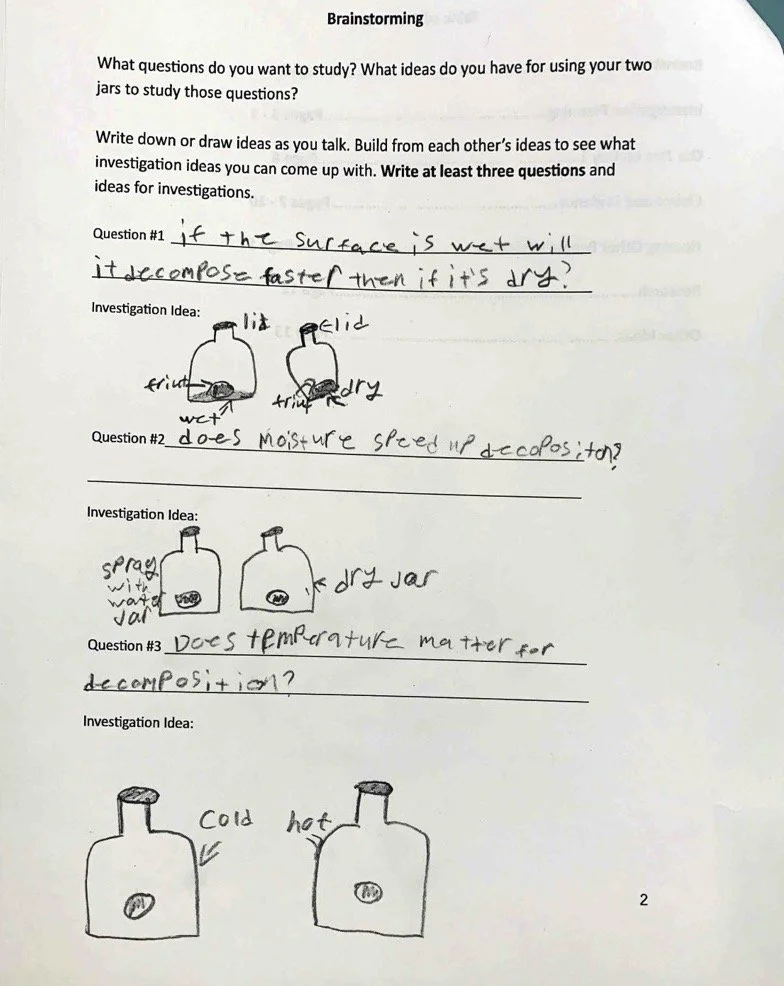What questions to investigate
It often takes work and knowledge to develop a question that (a) is worthy of further study with an investigation, (b) is possible to test given the time and materials available, and (c) can help you make progress toward understanding the phenomenon. Involving students in this work and sharing the responsibility for constructing questions can support student agency and interest while simultaneously allowing the teacher to know that students will make progress on important ideas through investigation.
A closer look at uncertainty in the classroom
When fifth grade students begin thinking about how plants decompose and design investigations of decomposition, they may not come up with investigation questions that help them understand important ideas about decomposition or that can be studied in the time and with the materials they have. Sam supported her students to participate in the work of developing questions through:
Evaluating investigation questions
Generating and refining class questions
Balancing question choice across teachers and students
Evaluating investigation questions
After students had conducted several observations of their class decomposition chamber and had begun to pose wonderings and potential explanations, Sam told them that they would be developing questions to investigate. She asked them what makes a good investigation question and contributed that questions should be investigable with the time and materials available and help the investigator figure something out. She pointed out that questions needed to be specific to generate useful investigations and engaged students in proposing ideas for how they would investigate some of the questions and possible explanations they had generated.
Students discussed how questions could be made more specific and testable, including by proposing possible explanations to test.
Generating and refining class questions
Sam then wrote some of the big questions she saw students coming up with – some that she knew would lend themselves to testing and some that were harder to investigate. She wrote each one on its own piece of chart paper. Students moved around the room, writing related questions, possible explanations that could be tested, and investigation ideas on the posters.
The results of students engaging with question posters. What do you notice about the ideas they came up with and how they evaluated what questions were testable?
Balancing question choice across teachers and students
Finally, Sam looked at the questions and ideas students generated and, from that, composed a list of potential investigation questions that students could choose from. She talked with students about why she had removed some (Do worms help decomposition? Why do decomposing thing smell?) based on their thinking and her thinking about what was harder or less ethical to investigate. Students then chose the question they wanted to investigate and began to think about how they would do so.
Student question choice sheet, with investigation ideas.
Instructional moves to support this form of uncertainty
Make sure students have enough experience with the phenomenon to share and disagree about tentative explanations that can motivate the need to investigate.
If you are posing an investigation question, take the time to link it back to the phenomenon and students’ previous discussion, connecting the question to making progress on an uncertainty or disagreement
Offer students the chance to evaluate potential investigation questions- e.g., proposing revisions, discussing which are better answered with informational text.
Provide some sentence starters and structures (Does xxx matter; Will y happen faster if x) but keep these varied and allow students to propose questions of other forms if those questions help them make progress on understanding something.
Where else does this form of uncertainty come up?
Explore Related Cases
Other Ways to Learn More
You can see the lesson plans and slides used to support students to develop questions in the Decomposition Investigation.



